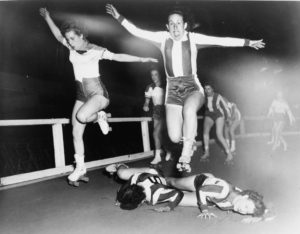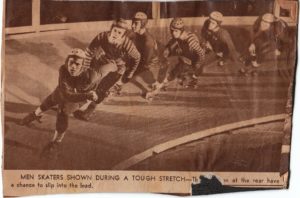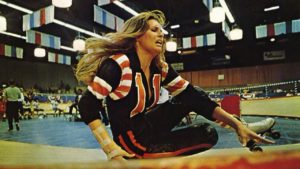 It wasn’t unusual for a Boomer kid of the 50’s or 60’s to have a Saturday or Sunday afternoon ritual: strolling through the living room to find dad glued to the screen while skaters went round and round a circular track whilst beating the crap out of each other.
It wasn’t unusual for a Boomer kid of the 50’s or 60’s to have a Saturday or Sunday afternoon ritual: strolling through the living room to find dad glued to the screen while skaters went round and round a circular track whilst beating the crap out of each other.
Such was roller derby, a sport which captivated the nation over a time period of about forty years.
It all began during the Great Depression. Film publicist Leo “Bromo” Seltzer was struggling, along with the rest of the nation. He saw the success of dance marathons, and decided to cash in on the fad with a twist: he would sponsor similar marathons, only with everyone on roller skates. Sometimes, this would amount to a large number of skaters on a circular or oval track of limited size. It was inevitable that tired skaters, who might have been at it for days, would occasionally get into massive pileups.
Writer Damon Runyan saw potential for the sport cashing in on its potential violent side, and convinced Seltzer to sponsor an “all-out” contest, in which elbowing, punching, and whip-cracking were encouraged.
 The public loved it, and roller derby was born. Male and female teams were organized, and the rules were the same for all, a unique situation in the world of spectator sports.
The public loved it, and roller derby was born. Male and female teams were organized, and the rules were the same for all, a unique situation in the world of spectator sports.
Roller derby went on the road shortly after, with teams traveling all over the country to give their exhibitions. There would always be a “home” team, playing a team from Chicago or New York, in each venue. The public loved it, and demanded more.
A tragic fiery bus crash in 1937 nearly put an early stop to roller derby. 19 or 20 people died (sources vary), and Seltzer had to scramble to hire more skaters. The number “1” was permanently retired in honor of those who lost their lives that day.
By the start of WWII, roller derby was hotter than ever. An estimated 50 million spectators attended matches in 1940. Some cities had their own permanent teams. However, the beginning of the war caused this sport, as in the case of many others, to virtually stop, while its participants enlisted in the armed forces.

After the war, Seltzer wasted no time in getting the sport on television. Roller derby had been broadcast on the radio prior to the war, and its hard-hitting action was a natural for TV. In 1948, CBS broadcast roller derby four nights per week. Many a bar had a TV, so its popularity soared ever higher, even though TV’s in general were still uncommon.
As the 50’s began, Seltzer found himself with some competition. International Roller Speedway was organized, and they practiced a game that varied just a bit from that of Seltzer’s Roller Derby organization. The sport featured a famous spunky participant named Eddie Cazar, whose life story was featured in a Mickey Rooney film of 1950, The Fireball.
Seltzer was still making lots of money, but was getting tired of the headaches of the day-to-day management of affairs, so in 1958, he turned over the reins of the business to his son. By 1961, the IRS (not THAT IRS, unfortunately 😉 had folded, but another rival, Roller Games, had arisen.
Seltzer had roller derby all over the airwaves during the 60’s and early 70’s. In 1972, Raquel Welch starred in Kansas City Bomber, a huge success for the sport. However, the faltering economy, high overhead, and the fuel crisis spawned by the Arab Oil Embargo caused Seltzer to fold things up. Roller Games lasted two more years, when it, too, closed up shop.
Nowadays, roller derby is still around. The Bay City Bombers, the sport’s most recognizable team, still exist, and play exhibition matches. From 1997 to 2001, Rollerjam appeared on TNN. And this year, interest in the sport may once again be spawned by Hollywood. Whip It, produced by Drew Barrymore, is scheduled for a fall release.
So here’s to one of the funnest, funkiest sports in history, one which greatly entertained us, our fathers, and likely our grandfathers during the decades before and after WWII, before the 1970’s economy put it on an extended leave of absence.